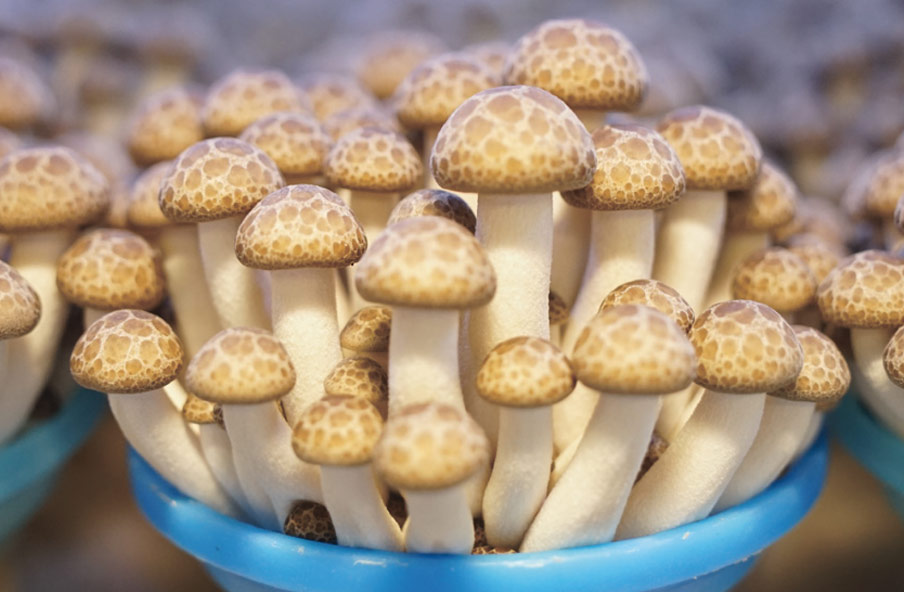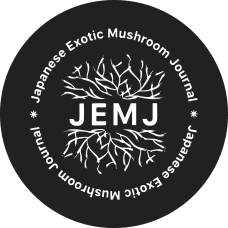Login or Subscribe
You must be logged in to access this content
Subscribe for free access to Japanese Exotic Mushroom Journal and gain insider knowledge on effective cultivation methods for Japanese mushroom species. Elevate your skills with expert tips and innovative technologies to master the art of growing Japanese exotic mushrooms.
◆ Discover exclusive Japanese mushroom cultivation techniques
◆ Learn innovative methods to enhance mushroom quality and yield
◆ Tap into Japan's rich heritage for unique growing insights
◆ Discover exclusive Japanese mushroom cultivation techniques
◆ Learn innovative methods to enhance mushroom quality and yield
◆ Tap into Japan's rich heritage for unique growing insights
Subscribe Now for Free Login
Shimeji Cultivation Basics
Shimeji cultivation techniques
IntroductionShimeji, also called bunashimeji, scientific name Hypsizygus marmoreus is a unique, peculiar and very commercially interesting mushroom species. First cultivated by the shochu brewer and food processing giant Takara Shuzou in the early 1970s, shimeji, as I said when I first covered them, were for the first fifteen or so years of their life a limited specialty item, being exclusively contracted to agricultural co-ops in Nagano Prefecture. Since the late 1980s the species has exploded in popularity and it is now on the cusp of overtaking enoki as the most cultivated and consumed mushroom in Japan.One interesting impact of the rise of shimeji is that they swiftly destroyed Japan’s domestic oyster mushroom industry. To the point where oyster mushrooms here, nationally, constitute just a few thousand tons of production (less than 1% of total mushroom production), and most of that consists of a single legacy product from Hokto and golden oyster mushrooms in Hokkaido, where they are a traditional delicacy. In contrast with most of the western world, where oyster mushrooms are both very popular and widely consumed, its difficult to find them anywhere in Japan, which is, after China, the second biggest mushroom producing country. Why is this?It is all the fault of shimeji. Namely, how shimeji defeated oyster mushrooms in most metrics. Oyster mushrooms were a pain to sell given how conscious Japanese consumers are of freshness, (leading to supermarkets to constantly be throwing away oyster mushrooms they couldn’t sell fast enough), which combined with their fragility, led to immense logistical challenges. In comparison, shimeji are simple. Shimeji have a 10~14-day shelf life, easily, and they form durable fruiting bodies that don’t fragment and handle well. If that wasn’t enough, shimeji also have considerably higher bioefficiency per bottle than oysters do, producing about 220 grams on an 850 ml bottle compared to only around 130 grams per bottle for a common black oyster mushroom variety.The only drawback anywhere with shimeji is their relatively long incubation that runs from 80~100 days, though there are some strains and some growers now that have experimented with shorter incubations down to around 70 days. The shorter incubation can impact fruiting consistency and lead to reduced yields, but there is still some hope that in the future a shorter cycle might become commercially feasible given the right spawn, substrate, and cultivation parameters (more on these later). Shimeji though, because of their soft stems, which have a much more pleasant texture than the tough, chewy stems of oyster mushrooms (which become particularly tough when oyster mushrooms are grown with bottle cultivation systems), and because they retain their bulk better, have become the go-to mushrooms in Japan for stewed dishes.I’ve broached this topic as well in the shimeji issue of the journal, published in 2023, but shimeji have a pleasant, neutral smell, and when cooked, lack any bitterness and have a relatively mild flavor with a faint nuttiness. They also do well to amplify the umami flavors and work well with most other ingredients. This has made shimeji popular in Japan, since they are easy to cook with, and many people now buy the pre-cut shimeji, which have the bottom of the cluster removed making them a bag of loose mushrooms. This has also contributed to the popularity of shimeji as a quick, easy to use mushroom. The texture as well is lighter, less chewy, and without any peculiar crunchiness or crispness, which makes them easier to feed to kids and other people who are picky about food textures.
Substrate
The substrate mixing for shimeji is quite complicated. One element of bottle cultivation systems, is that substrate is even more carefully managed than with bag cultivation systems and the demands higher and the margins of error lower. For shimeji, the standard base is a mixture of beech and cedar sawdust, but without proper supplementation the results will be poor. Six of the most common nutrition supplements, which are used to add nitrogen and certain minerals, or otherwise adjust the physical properties of the substrate, are: ground corn cob, rice bran, wheat bran, soybean hulls, cottonseed hulls, and dried tofu lees (soybean pulp, called okara, which I have also mentioned before in this journal). Lastly, calcium-based pH regulators like lime are also used, but these should average to under 2.5g per 850ml bottle.- One very generic recipe, to offer up one that is used as an example in a guide book I have on shimeji cultivation, calls for 20g corn cob, 50g rice bran, 20g wheat bran, and 10g dried tofu lees per 850ml bottle (all figures represent dry weights), with the remaining 400 grams sawdust. This is just one approach though. Cottonseed hulls, for instance, have good water retention, and might be especially useful in a region with a dry climate or could be added seasonally during drier seasons. Soybean hulls are also useful for increasing yields, but they are easy food for many other molds and bacteria, so you don’t want to add too much. They also inflate considerably when water is added, so the total amount should be kept small if used.
Here I am just briefly going over a small fraction of the calculations that go into making a substrate, and many other nutrition supplements are possible, depending on the local agro-waste streams and the cost-point. As I have said elsewhere, farms shouldn’t get too caught up in some idea of perfection that they pay more than a substrate component is worth; perfect is what gets the job done and is simplest and cheapest to get your hands on.
Shimeji substrate runs around 66~70% water content at filling.
Sterilization and Spawning
In Japan the standard sterilization process uses a pressurized autoclave reaching max temperatures of 118 degrees Celsius, which they hold for thirty minutes before the cool down starts. These cycles are typically four hours. However, non-pressurized autoclaves operating at under .5 bars of pressure and maximum temperatures of 108~110 degrees Celsius running on a longer eight-hour cycle can also be used to sterilize substrate. It is very important however, that substrate be sterile, not just pasteurized, and that a farm upholds extremely high hygiene standards.
The industry standard in Japan is for a double-sided autoclave, the back end of which opens into a cooling room with reverse laminar flow that is connected to or part of the inoculation room. Hygiene standards fort the inoculation room should be well known, but they include changing in to full-body clean room suits, covering of hair, disposable latex gloves, and sometimes include facial masks as well. Prior to entry, workers use a lint roller over their bodies and go through an air shower. In Japan, some clean rooms can be at the hygienic standards of a surgery ward in a major hospital.
Incubation
As I mentioned above, shimeji have an 80~100-day incubation cycle. Incubation temperature settings range from 21~23 degrees Celsius. As I have written before, in the initial phases, up to the first month, is when you see the highest levels of metabolic activity. While the spawn is colonizing the substrate, the mycelia generate a lot of excess heat. That is why it is fairly standard in Japan to run incubation at the lower range during that time period, which for shimeji would be around 21 degrees Celsius for the first month. Afterwards, you can allow the thermometer to go up a little.
It is also important to make sure that there is good air flow in the incubation room, with fans circulating the air (small fans, not huge industrial fans). When you have a room with almost 8 meters to the ceiling and two pallet-high stacks of tightly packed bottles, it is easy to get dead spots even with proper HVAC systems with HEPA filtration. These dead spots can both overheat and/or have excessive CO2 concentrations. Over all, for shimeji incubation, the CO2 concentration can be as high as 4500 ppm, but it should never exceed 5000 ppm for even a short period of time. Humidity should be maintained at 65%.
Pinning and Fruiting
After fungal scraping, the bottles of shimeji substrate should be moved to a pinning and fruiting room. The ideal temperature range is 14~15 degrees Celsius. One thing about shimeji is the extremely high humidity in the fruiting room, as close to 100% saturation as a farm can maintain. CO2 saturation should remain under 2000 ppm during this period of time. Japanese farms have LED light systems built around the shelving, and a 12-hour light cycles with 15~30 minutes exposure to light at a time. Blue LED lighting has shown the best performance. A proper lighting cycle is important for pinning formation and maximizing yields. Light intensities should be between 500~1000 lux. Pinning to harvest typically requires between 20~22 days. - Wrapping up
This is a very cursory view of shimeji cultivation, but I have touched on the standard settings and given a generalized overview of the cultivation process in this article. I would like to emphasize that readers should not take this advice as universal. Shimeji are a high-performing variety, but there are plenty of components, some small, some big, that I cannot go into with a short primer like this. What is more, when growing shimeji via filter bag systems, the parameters of best practice will likely display some significant differences between Japan’s bottle system growing methods. Before beginning commercial cultivation of shimeji, I would definitely recommend contacting our parent company SALAI International Japan. Each farm is different, so getting the best performance generally requires personalized consultations.





 1-2-13 Honmachi, Komoro city, Nagano prefecture, Japan 384-0026
1-2-13 Honmachi, Komoro city, Nagano prefecture, Japan 384-0026